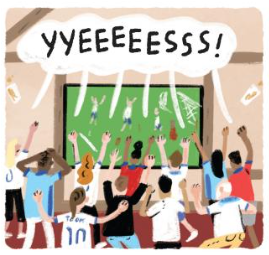Short Takes From the Past Week
Skip to commentsBob Staake, Mick Stevens, Paul Karasik, Max Fleischer, Peanuts, and The Nib.
**********
Staake has publicly rejected the idea that he has a “style” — his works are too different, he says, his way too experimental. But every piece in the show, he admits, looks like a Bob Staake. “There’s something hiding in the background,” he says, whether the piece is photorealistic, “completely silly,” design focused, or aesthetically midcentury modern. “Maybe it’s a point of view, maybe it’s a sense of composition,” he says. Maybe it’s his interest in “communicating, entertaining, engaging with people.”

Dorothea Samaha, at The Provincetown Independent, talks to Bob Staake about his ongoing exhibit.
The event: “The Endless Imagination of Bob Staake”
The time: Through Oct. 15
The place: Cape Cod Museum of Art, 60 Hope Lane, Dennis
The cost: General admission: $10
**********
When I first heard about The Nib shutting down, I felt like I’d been gut-punched. It’s weird, but it had felt like, somehow, The Nib would always be there, supporting amazing comics journalism, political cartoons, memoir, and short nonfiction comics. It became an institution.

Kerry Vineberg and The Beat sadly bids farewell to The Nib.
[Matt] Bors has been joined at The Nib by a stellar team, including features editor Eleri Harris, associate editor Mattie Lubchansky, contributing editors Shay Mirk, Whit Taylor, and Andy Warner, and designer Mark Kaufman.
They’ve given me hope for the medium. They’ve incubated and elevated a generation of talented creators and treated them with respect
**********
In animation history, Max Fleischer stands on a par with Walt Disney, and Looney Tunes masterminds Hugh Harman and Rudolf Ising. Creator of Betty Boop, inventor of the rotoscope, the producer who brought the four-panel funnies of Popeye the Sailor Man and four-color adventures of Superman to the silver screen … Yet for many reasons – corporate double-dealing, time, changing tastes – his pivotal role in the birth of cartoons is often overlooked.

Unless you live in Austin it’s too late to take in AFS Cinema’s the Fleischer Studios Legacy show (July 4 and 5), but Richard Whittaker and The Austin Chronicle offer some background on the Fleischer Studios Legacy.
A cartoonist and illustrator by trade, Fleischer invented the rotoscope in 1915 (supposedly on a dare from his editor at Popular Science Monthly, Waldemar Kaempffert) as a way to smooth out early, jerky animation techniques. Rotoscoping – allowing animators to draw over live footage – sped up production, and quickly Fleischer Studios was producing dozens of shorts a year.
Help support Fabulous Fleischer Cartoons Restored! at patreon.com/fleischertoons.
**********
Last Friday [Kate Feiffer] sat down with cartoonists Mick Stevens and Paul Karasik in the gallery space of the Martha’s Vineyard Playhouse, where some of Stevens’ cartoons are currently being exhibited. I had gone to the opening of his show, and wanted to see it again. When you see a great cartoon, you often find yourself thinking and laughing about it days later. Cartoonists have a way of hitting the sweet spot.


Kate Feifferr, for Martha’s Vineyard Times talks to cartoonists Mick Stevens and Paul Karasik.
Another outing to put on your calendar is to come hear Mick Stevens and Paul Karasik at Islanders Write on Monday, August 21, at 11:30 am, for “Thinking in Ink with Two New Yorker Cartoonists.”
“Ink to Ink — Original Art by Mick Stevens for Work Published in the New Yorker” will be at the M.V. Playhouse Art Space until August 12.
**********
A Syracuse professor claims Peanuts, the long-running comic strip featuring Charlie Brown, is the longest story ever told by one person. Is it?

The comic strip Peanuts, featuring an iconic cast of characters led by Charlie Brown, was written and drawn by Charles Schulz for nearly 50 years, and according to Robert Thompson, a professor of pop culture at Syracuse University, that makes it the longest story ever told by a single individual.
Grant Gregory, at ScreenRant, looks into the professor’s theory, dismissing War and Peace:
With an average word count of 28 words per daily strip, and 70 words per Sunday strip, Peanuts was approximately 606,368 words long. By comparison, Tolstoy’s War and Peace checks in at 587,287 words.
Though noting:
the Harry Potter series was 1,084,170 words long. Almost, but not quite twice as many words as the entirety of the Peanuts canon. George R.R. Martin has been writing his A Song of Ice and Fire series, beginning with Game of Thrones, for over 15 years and 1,736,054 words – and still counting. Outpacing them all, Robert Jordan’s Wheel of Time books total over four million words.
Returning to comics Grant tosses out the 41 years Erik Larsen has put in on The Savage Dragon and more.
Not mentioned is Russell Myers 53-and-still-going years on Broom-Hilda.


Comments 2
Comments are closed.